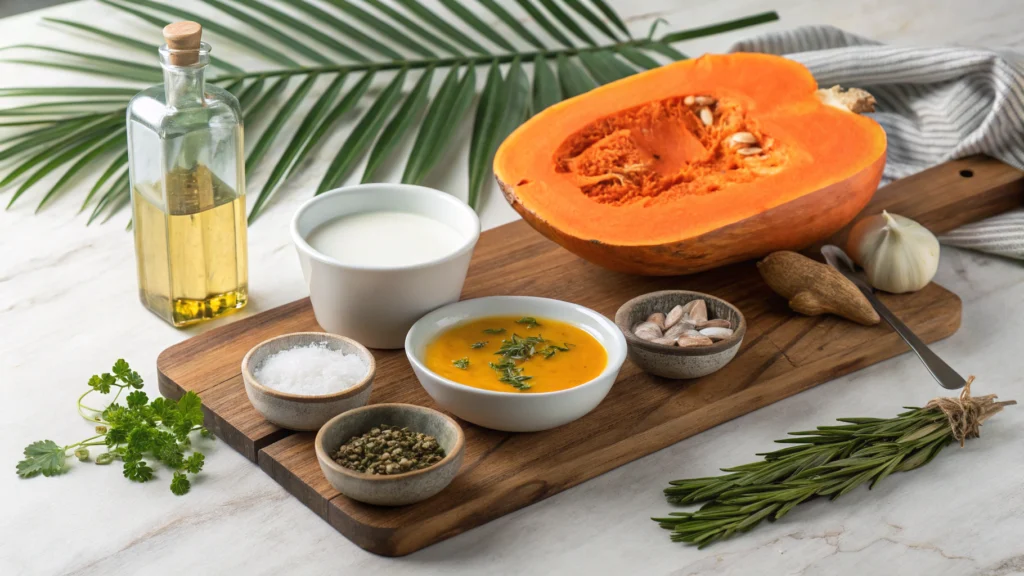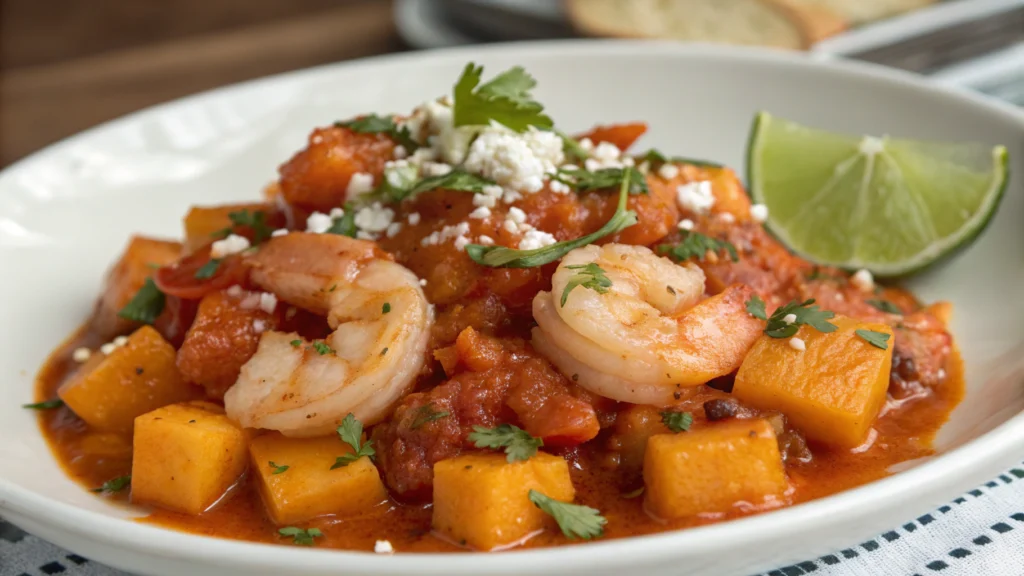
Introduction to Calabaza’s Culinary Charm
The Allure of squash in Caribbean Cuisine
Calabaza, a colorful squash beloved in Caribbean cuisine, brings both warmth and versatility to every dish. Its sunset-hued flesh, sweet yet subtly earthy, forms the backbone of countless island dishes. From Jamaica to Puerto Rico, this gourd weaves its way into stews, sides, and soups, embodying the region’s soulful culinary ethos. Its ability to meld with bold spices or creamy textures makes it a cherished ingredient.
A Fusion of Flavors: Coconut and Calabaza
This recipe marries calabaza with coconut, a pairing that evokes the tropics. The silken richness of coconut milk tempers the squash’s sweetness, creating a soup that’s both indulgent and comforting. Paired with roasted calabaza, kissed by herbs and garlic, the dish offers a symphony of textures and tastes. It’s a celebration of Caribbean ingenuity, where simple ingredients transform into something extraordinary.
Setting the Scene for a Cozy Meal
Imagine a table set with steaming bowls of crema de calabaza y coco, golden roasted calabaza wedges on the side, and the faint aroma of cumin and cilantro in the air. This meal invites warmth, perfect for a crisp evening or a gathering of loved ones. It’s food that nourishes both body and spirit, grounding yet exotic.
Description of the Dish
The Essence of Crema de Calabaza y Coco
Crema de Calabaza y Coco is a smooth, luxurious soup that blends the naturally sweet, nutty flavor of calabaza with the rich, silky texture of coconut milk. Infused with ginger, cumin, and nutmeg, it carries a subtle warmth that lingers on the palate. Each spoonful feels like a gentle embrace, with the calabaza’s tender texture melting into the coconut’s opulent depth. This dish, rooted in Caribbean tradition, elevates humble ingredients into a luxurious experience.
Roasted Calabaza: A Perfect Companion
The roasted squash, with its caramelized edges and herbaceous notes, serves as the ideal counterpoint. Olive oil, thyme, and rosemary coax out the squash’s natural sugars, while garlic adds a savory depth. The result is a side dish that’s crisp yet tender, rustic yet refined. It complements the soup’s creaminess with a satisfying crunch.
Why This Recipe Captivates the Palate
This duo captivates through its balance of flavors and textures. The soup’s silken consistency contrasts with the roasted calabaza’s crisp exterior, while the interplay of sweet, savory, and aromatic elements keeps each bite intriguing. It’s a dish that feels both familiar and adventurous, inviting diners to savor the Caribbean’s vibrant culinary heritage.

Preparation and Cooking Times
Time Breakdown for Soup Preparation
The crema de squash y coco requires 20 minutes of preparation, including peeling and cubing the calabaza, dicing onions, and grating ginger. Cooking takes 25-30 minutes, primarily for simmering the soup to meld flavors. Total time hovers around 45-50 minutes.
Roasting Time for Calabaza
Roasted calabaza demands 10 minutes of prep—slicing wedges and tossing with seasonings. Roasting at 400°F takes 25-30 minutes, with a midway flip to ensure even caramelization. Expect about 35-40 minutes total for this component.
Tips for Efficient Kitchen Workflow
To streamline, prepare the soup while the calabaza roasts. Cube the squash for the soup first, then slice wedges for roasting. Preheat the oven early, and keep a timer to coordinate both dishes finishing simultaneously. This ensures a hot, cohesive meal
🥢 Ingredients for Crema de Calabaza y Coco

Core Components for the Soup
✅ 1 medium calabaza (about 2 lbs), peeled and cubed
✅ 1 can (13.5 oz) coconut milk
✅ 1 medium onion, diced
✅ 2 cloves garlic, minced
✅ 1-inch piece fresh ginger, grated
✅ 4 cups vegetable broth
✅ 1 tbsp olive oil
✅ 1 tsp ground cumin
✅ 1/2 tsp ground nutmeg
✅ Salt and pepper to taste
✅ Fresh cilantro for garnish
Ingredients for Roasted Calabaza Side
✅ 1 medium calabaza (about 1.5 lbs), cut into wedges
✅ 2 tbsp olive oil
✅ 1 tsp dried thyme
✅ 1 tsp dried rosemary
✅ 2 cloves garlic, minced
✅ Salt and pepper to taste
Sourcing Quality Calabaza and Coconut
Seek out calabaza with firm, unblemished skin and a deep orange hue, signaling ripeness and flavor. Farmers’ markets or Latin American grocers often stock this squash. For coconut milk, opt for full-fat versions without additives to ensure a rich, authentic taste. Fresh herbs and high-quality olive oil elevate the dish’s vibrancy.
👨🍳 Instructions :
Preparing the Crema de Calabaza y Coco
Begin with a large pot over medium heat. Heat 1 tablespoon of olive oil in a pan, then sauté the diced onion, minced garlic, and grated ginger for 3–4 minutes until fragrant. Next, add the cubed calabaza along with cumin and nutmeg, stirring well to ensure everything is evenly coated.. Pour in vegetable broth and coconut milk. Bring to a gentle boil, then reduce to a simmer. Cook for 20-25 minutes until the calabaza softens. Blend with an immersion blender until silky. Season with salt and pepper.
Roasting the Calabaza to Perfection
Preheat the oven to 400°F (200°C). Toss calabaza wedges with 2 tablespoons of olive oil, thyme, rosemary, minced garlic, salt, and pepper. Spread them out evenly on a baking sheet, making sure they’re in a single layer. Roast for 25-30 minutes, flipping halfway, until golden and slightly crisp at the edges. Check for tenderness with a fork.
Combining for a Harmonious Meal
Ladle the hot soup into bowls, garnishing with fresh cilantro for a burst of color and flavor. Serve alongside a plate of roasted calabaza wedges, letting diners enjoy the interplay of creamy and crisp textures. The meal feels complete yet light, perfect for any season.
💡 Cooking Tips for Success:
Enhancing Flavors with Spices
Toast cumin seeds before grinding for a deeper, nuttier flavor. A pinch of smoked paprika can add a subtle smokiness to the soup. Freshly grated nutmeg outperforms pre-ground for its aromatic intensity. Taste and adjust seasoning before serving.
Texture Tips for Creamy Soup
For an ultra-smooth soup, blend in small batches if using a countertop blender, ensuring no chunks remain. If a thicker consistency is desired, reduce the broth by half a cup. For a lighter soup, add a splash more broth during blending.
Storage and Reheating Advice
Store leftover soup and roasted squash separately in airtight containers in the refrigerator for up to 4 days. Reheat soup gently on the stovetop, stirring to maintain creaminess. Reheat roasted squash in the oven at 350°F for 10 minutes to restore crispness.
📊Nutrition Information (per serving)
Caloric Breakdown per Serving
Each serving—one bowl of soup with 2 to 3 roasted wedges—contains about 320 calories. The rich, creamy coconut milk is the main source of calories in the soup. The roasted squash contributes few calories but helps increase fullness and satisfaction.
Macronutrient Profile
Total fat sits at 22 grams, with 14 grams of saturated fat from coconut milk. Cholesterol is absent, making this dish heart-friendly. Sodium clocks in at 780 mg, largely from broth, while carbohydrates total 28 grams, including 5 grams of dietary fiber and 8 grams of sugars. Protein is modest at 5 grams.
Conclusion: A Celebration of Caribbean Comfort

Pairing Suggestions for the Meal
Pair this dish with crusty bread or a light green salad to round out the meal. A chilled glass of sauvignon blanc or a hibiscus tea complements the tropical notes. For dessert, consider a mango sorbet to stay true to the Caribbean theme.
Embracing the Warmth of squash
This recipe captures the essence of calabaza’s versatility, transforming it into a meal that feels like a warm hug. Its vibrant colors and bold flavors evoke the Caribbean’s sun-drenched landscapes, inviting diners to savor each bite.
Encouraging Culinary Exploration
Experiment with this recipe by adding a dash of chili for heat or swapping herbs for a different twist. Calabaza’s adaptability encourages creativity, making it a canvas for culinary exploration. Dive into the world of Caribbean flavors and let this dish inspire future kitchen adventures.
Related






please don’t forget to leave a review
